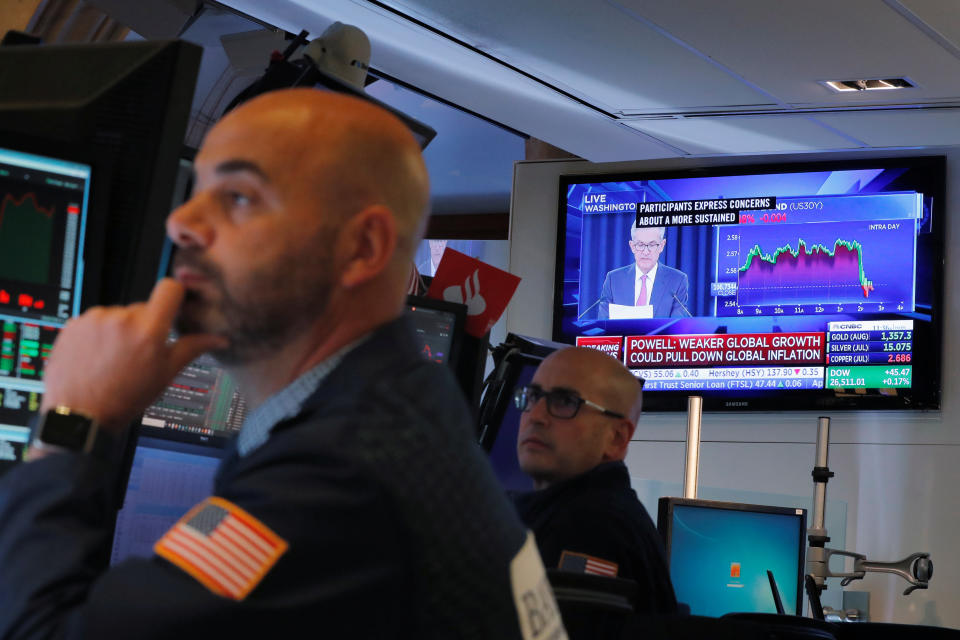S&P 500 crosses 3,000 for the first time ever after Fed Chair Powell suggests rate cut
U.S. stocks ended higher Wednesday, pulling back slightly from record highs after remarks from Federal Reserve Chair Jerome Powell’s congressional testimony suggested the central bank remained open to a near-term rate cut.
The S&P 500 (^GSPC) advanced 0.45%, or 13.44 points, as of market close, with the energy sector leading gains as domestic crude oil prices (CL=F) rose 4%. The blue chip index pared some gains to close at 2,993.07 points, after earlier hitting a new intraday high of 3,002.98. This marked the first time ever that the S&P 500 crossed the 3,000 level.
The Dow (^DJI) rose 0.29%, or 76.71 points, and also came off the highs of the day by market close. The 30-stock index reached a new record intraday high of 26,983.4 points.
The Nasdaq (^IXIC) increased 0.75%, or 60.8 points, retreating slightly after hitting a new intraday high of 8,228.6.
Treasury yields fluctuated in the wake of the first of two days of Powell’s congressional testimony. The more policy-sensitive short term government bond yields fell sharply, with the two-year yield down 7.7 basis points to 1.828% around 4 p.m. ET. Treasury yields move inversely to prices.
Powell delivered his semi-annual Monetary Policy Report before Congress in a more than three hour session Wednesday morning. In prepared remarks, Powell said that “uncertainties” around trade tensions and the strength of the global economy continued to mire the central bank’s U.S. economic outlook. He reiterated that many Fed officials at the June meeting saw that “the case for a somewhat more accommodative monetary policy had strengthened.”
‘Insurance’
Ahead of Powell’s address, equity markets were cheering for Powell to affirm that the Fed would move forward with easier monetary policy, even after stronger-than-expected employment data last week reflected a still-strong domestic economy. As the testimony carried on, many observers believed the Powell had all but guaranteed that the central bank would cut rates by the end of its July meeting.
“The Fed seems to be willing to dismiss the better data from the U.S. and instead is focusing on the weaker global data,” Bank of America Merrill Lynch analysts wrote in a note Wednesday afternoon. “Indeed, when Powell was asked if the strong jobs report changed his views on cuts, he stated ‘no.’”
Other economists interpreted Powell’s remarks similarly.
“Chair Jerome Powell’s semi-annual testimony to Congress indicates that, despite the trade truce following the recent G-20 meeting and the strength of employment growth in June, the Fed intends to push ahead with a rate cut at the FOMC meeting at the end of this month,” Paul Ashworth, chief U.S. economist for Capital Economics, wrote in a note.
“The rate cut is an insurance against the downside risks that Fed officials believe have mounted in recent months as ‘economic momentum appears to have slowed in some major foreign economies’ with ‘crosscurrents,’ such as trade tensions and those global growth concerns, weighing on U.S. economic activity,” Ashworth explained.

Earlier Wednesday morning, fed funds futures had showed a slim possibility of no change to the current level of borrowing costs after the Fed’s July meeting for the first time in weeks, according to CME Group data. However, after Powell’s prepared remarks were released, futures re-calibrated to show markets pricing in a 100% probability of an at least 25 basis point cut to benchmark interest rates.
Wednesday afternoon, the Fed released the minutes from its June 18-19 policy meeting, which mostly reiterated sentiments from Powell’s testimony. The document provided details of how central bankers viewed risks from the trade war between the U.S. and China, before the meeting between President Donald Trump and China’s Xi Jinping took place at the G-20 summit.
On Tuesday, U.S. Trade Representative Robert Lighthizer and Treasury Secretary Steven Mnuchin spoke on the phone with China’s Vice Premier Liu He and Commerce Minister Zhong Shan, China’s Ministry of Commerce confirmed in a statement Wednesday. Few details were provided over the contents of the phone call, which marked the first confirmed contact between the two sides since Trump and Xi met last month and said they would resume trade talks.
Elsewhere, the euro-area continued to be dragged down by trade tensions and policy concerns, according to a new assessment from the the European Commission. The commission on Tuesday cut its euro-area growth forecast for 2020 to 1.4%, from the 1.5% pace of increase expected in the spring. It also slashed its inflation forecast for both 2019 and 2020 to 1.3%, down from 1.4% for each year seen previously.
Meanwhile, economic growth in the U.K. rebounded in May to a 0.3% pace of expansion, after contracting by 0.4% in April, the Office for National Statistics reported Wednesday. The economy grew a better-than-expected 0.3% for the three months to the end of May, amid an easing of concerns of a no-deal Brexit after March and April.
—
Emily McCormick is a reporter for Yahoo Finance. Follow her on Twitter: @emily_mcck
Read more from Emily:
Follow Yahoo Finance on Twitter, Facebook, Instagram, Flipboard, LinkedIn, and reddit.
Read the latest financial and business news from Yahoo Finance

 Yahoo Finance
Yahoo Finance 